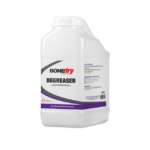Why Does My Concrete Floor Sweat?
Concrete floors sweat when warm, humid air comes into contact with the colder concrete slab, causing condensation to build up on the surface.
What is the source of your concrete dampness?
- High Humidity: Failing ventilation in your space can cause humidity to excessively build up and force your concrete floor to sweat, even when your vapor barrier is functioning.
- Faulty or Missing Vapor Barrier: When the vapor barrier underneath your concrete floor isn’t working properly, moisture from the ground will seep up and bead on top of your floor.
How to test for the source of concrete moisture
To determine whether the moisture on your concrete floor is caused by humidity or a faulty vapor barrier, follow these steps:
- Tape a 2×2 ft square of plastic sheeting onto a dry area of the concrete surface.
- Leave the plastic sheeting in place for at least 48 hours.
- After 48 hours, remove the plastic and check for moisture condensation.
If you notice beaded moisture under the plastic sheet, it’s likely due to a faulty or missing vapor barrier. If there is no beaded moisture, the problem is probably related to high humidity in your space. In the case of high humidity, improving ventilation and controlling the temperature should help resolve the problem.
Bone Dry Sealers and Etch-A-Crete with Concrete Moisture Problems
Bone Dry Etch-A-Crete is an eco-friendly, user-friendly blend of mild acids, emulsifiers, enzymes and wetting agents designed to etch troweled concrete and open the surface for the application of Bone Dry Penetrating Concrete Sealers.
If you have a problem with your vapor barrier, Bone Dry Products provides concrete sealers with a chemical vapor barrier to mitigate moisture in concrete substances like garage floors, warehouses, basements and more. Our sealers fill capillaries and gaps, permanently blocking the transmission of moisture up through the concrete slab and preventing moisture issues.
Bone Dry concrete sealers are an affordable alternative to epoxy sealers and are simple to apply indoors or outdoors using a standard pressurized garden sprayer. With a curing time of just 6 hours, our range of moisture mitigation products offers permanent solutions for sealing both large commercial structures and residential spaces.






